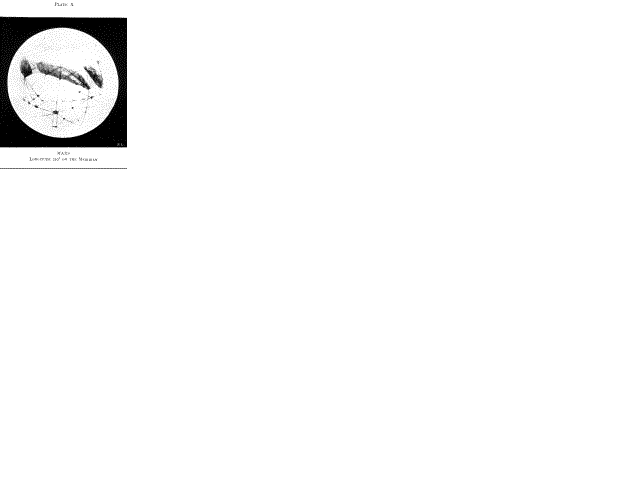Between the dark regions and the Beak of the Sirens is the peninsula Phaetontis, crossing which some way up is a short canal known as Herculis Columnae. Due north of the Lacus Phoenicis is the spot Ceraunius, joined to the Lacus Phoenicis by the Iris, and to the Tithonius Lacus by the Fortunae. It is also crossed by the Gigas, the very long canal in the right hand lower part of the disk, of which we saw the beginning in the last plate, and shall not see the end till we reach the next one.
Westward of the Lacus Phoenicis there begins to show a congeries of spots and connecting canals,
which come out still more strikingly in Plate VII.
The great canal beaded with spots, which in the picture
traverses nearly the centre of the disk, is the Eumenides, and its continuation, the Orcus. Its farther
end is lost in the limb-light. At an angle to it, running nearly northwest from the Lacus Phoenicis, is
the Pyriphlegethon. In this plate the Sea of the Sirens is well on, its beak being almost on the central
meridian. From its north coast strike down a great many canals, all going as far as the Eumenides and
some continuing past it. The first one from the Beak of the Sirens is the Sirenius. It crosses the Eumenides
at the first of its large spots after leaving the Phoenix Lake, the Lucus Arsine. To the next spot, known
as the Nodus Gordii, the Gorgon comes down from the centre of the coast-line, meeting the Gigas, which
itself debouches, at the west end of the sea, into what is called the Sinus Titanum, or Gulf of the Titans.

In Plate VIII. the Sinus Titanum has come round into view. Owing to its conspicuousness at certain
seasons, it is one of the most important features on the planet to us, and seems to be to the planet
itself, as some seven canals radiate from it. These are the Gigas, previously described, and to the right,
in the order here enumerated, the Steropes, the Brontes, the Titan,--the one straight down the disk,--the
Arges, the Gyes, and the Tartarus; the last travelling to the Trivium Charontis invisible in this plate. Of
the separate existence of the Arges and the Gyes I am not quite certain. These great canals show like
the sticks of a fan, with the Sinus itself for pivot.
The Sea of the Sirens is now nearly central. To the west, dividing it from the Mare Cimmerium, which is just coming into view, is the peninsula Atlantis, curiously uniting the continents to the islands to the south. Belting the disk from east to west is the Eumenides-Orcus strung with spots.
Parallel to the Eumenides-Orcus, and skirting the north shore of the Sea of the Sirens, is the Erynnis. Half way between this and the Eumenides is another parallel canal, the Parcae. Curving round the bottom of the disk is a chain of canals, the Pyriphlegethon, Acheron, and Erebus, the last of which runs to the Trivium Charontis. At the junctions of these various canals may be seen any number of spots.

On the next plate (Plate IX.) the Trivium Charontis itself has come into view toward the lower right-hand
part of the disk. Two nearly parallel canals, a double Hades, join it to the Propontis, the Spot almost at
the limb. The Titan shows well near the centre of the disk. Were the centre ten degrees farther east,
the canal would appear more striking yet. For so straight is it, and so nearly due north and south does
it lie, that when it comes to the meridian it seems that meridian itself. On this plate we have the western
end of the Eumenides-Orcus, at whose eastern end we began several plates back when we left the
Phoenix Lake. This will give some idea of the immense length of the canal, which is no less than three
thousand four hundred and fifty miles long. Nearly in the centre of the disk is the peninsula Atlantis,
the most easterly of the set of comet-tail peninsulas similar to those seen in Plate I., all connecting the
so-called continent with the islands to the south. These islands look not unlike great vertebrae of the
planet's backbone, in consequence of the canals which cut them up so symmetrically. Atlantis shows
well, between Mare Sirenum and Mare Cimmerium, two areas suggestively alike in general shape and
directional trend. Both are seen to be crossed by canals which connect, at what resemble nicks in the
coast-line, with the canals in the bright regions.

In Plate X. the Mare Cimmerium is central. So, also, well down the disk, is the Trivium Charontis. This
is a very important junction, no less than nine canals already being known to connect with it ,which,
taken in the order, east, north, west, and south, are the Orcus, the Erebus, the twin Hades, the Styx,
the Cambyses, the Cerberus, the Laestrygon, the Tartarus, and so back to the Orcus again. In this
picture the Laestrygon traverses nearly the centre of the disk. To the right of the Trivium Charontis is
| Previous chapter/page | Back | Home | Email this | Search | Discuss | Bookmark | Next chapter/page |